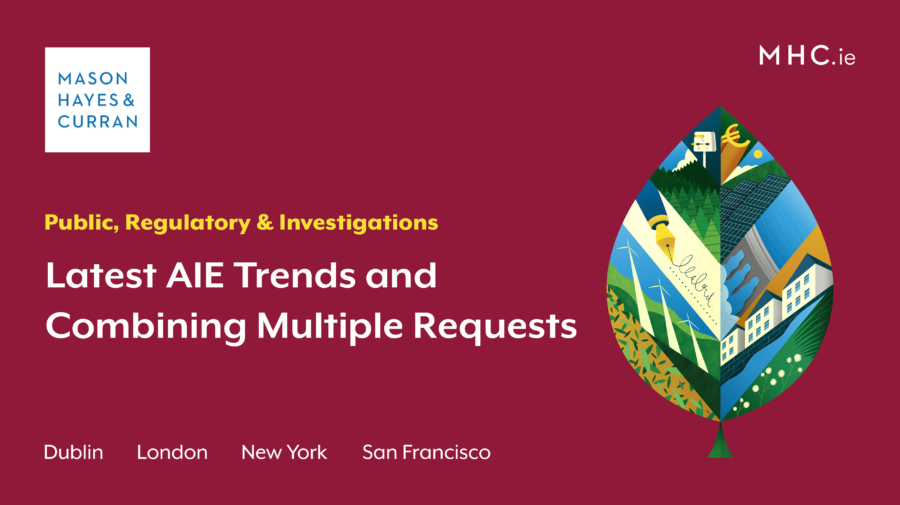
The Office of the Commissioner for Environmental Information has published its first dedicated annual report reviewing its 2022 activity which it has described as “remarkable”. The OCEI commented on “poor quality decision-making by public authorities”. Our Public, Regulatory & Investigations team examines the key trends and the OCEI’s views on how public authorities should process multiple requests from the same individual.
The Office of the Commissioner for Environmental Information (OCEI) received 151% more appeals in 2022 compared to 2021. Access to Information on the Environment (AIE) requests have doubled in a year. There has been a particular increase in cases related to forestry with over 69% of appeals received in 2022 relating to forestry. Of the 129 appeals processed by the OCEI, only four were affirmed. This, according to the OCEI, demonstrates a lack of understanding of and commitment by public authorities to their statutory obligations under the AIE Regulations.
Comments by the OCEI on combining requests may be of particular interest to public authorities when dealing with multiple requests from the same requester.
The OCEI has also published useful guidance for public authorities on processing AIE requests.
Combining requests
The OCEI accepts that, where a requester sends multiple communications to a public authority over a short time, there are circumstances where some of these separate communications may be considered as a single request, or a smaller number of requests. This could result in the public authority combining the requests along thematic or temporal lines.
The OCEI emphasised the importance of a public authority working collaboratively with the requester where they feel that a request is manifestly unreasonable. The OCEI also stressed that regard must be afforded to the volume or range of information sought. Therefore, the first step will always be to assist the requester to reformulate the request(s) with a view to fully processing the request(s) as efficiently as possible. It may be necessary to extend the timeframe for responding to the request which should take place as soon as possible, within the first month.
When considering whether a request is manifestly unreasonable, the OCEI has said that it will be necessary to examine the impact on the public authority of dealing with the request(s) and consider whether responding to the request would:
- Involve disproportionate cost or effort, or
- Obstruct or significantly interfere with the normal course of its activities
The responsibility is on the public authority to demonstrate that the task entailed by the request is unreasonable and reasons will need to be provided.
Case Study 1: Land Development Agency
The OCEI considered four appeals lodged by the same requester. The OCEI noted that the appeals were very similar in nature, used the same terminology, and requested information on a similar subject matter. The original requests were all submitted to the Land Development Agency at the same time in the same envelope. In noting that the term “request” is not defined in the AIE Regulations, the OCEI considered it reasonable to consider these four separate requests to be a multi-part request, particularly where doing so would achieve efficiencies in responding to the requester. However, the OCEI found that the Agency, when reaching a conclusion that the requests, taken together, were manifestly unreasonable under Article 9(2)(a) of the AIE Regulations, had not shown that it had:
- Considered each element of the request
- Weighted the public interest for each element of the request
- Carried out an analysis under Article 10(5) of the AIE Regulations. Article 10(5) requires public authorities to carry out an assessment of whether information to which an exemption under Article 8 or 9 applies may be separated out from other environmental information which may be released.
The OCEI annulled the Agency’s decision and directed it to undertake a fresh decision-making process.
Case Study 2: Coillte
The requester in this case made 19 requests to Coillte between 26 November 2021 and 9 January 2022. Coillte considered the requests together and refused them on the basis that they were manifestly unreasonable. Coillte argued that, due to the cumulative nature of the requests, the overall time and resources required to comply would impose a heavy burden on Coillte. It also stated that the requests would unreasonably and disproportionately divert it from and disrupt it in performing its core functions.
As in case study 1, the OCEI accepted that the practical implication of a case such as this is that some of the separate communications may reasonably be considered as a single request or smaller number of requests. The Commissioner emphasised that this grouping of requests ideally should be done with co-operation between the parties as the streamlining the number of requests and responses would “be mutually beneficial for the efficiency of the process.” The Commissioner acknowledged that the volume of information requested by the requester represented a challenge for Coillte but also highlighted the importance of compliance with each of the requirements of the AIE Regulations.
In annulling Coillte’s decision, the OCEI pointed to:
- The importance of carrying out an analysis under Article 10(5) to assess whether parts of the requests could be separated out in order to provide a response to those parts.
- A public authority’s obligation to maintain environmental information in a manner that is readily reproducible and accessible (Article 5(1)(b) of the AIE Regulations). In this context, it appeared to the OCEI that some of the requested information was of a kind that the OCEI would expect to be readily available for provision to the public.
Conclusion
These case studies demonstrate an acceptance by the Office of the Commissioner for Environmental Information of combining multiple requests from a requester and processing them along temporal or thematic lines. However, the OCEI does not appear to accept the premise that the public authorities may combine requests to refuse them on the grounds that, taken together, they are manifestly unreasonable. Instead, according to the OCEI, the public authority should work in collaboration with the requester to streamline the requests and responses for the mutual benefit of both parties.
For more information on complying with the AIE Regulation in full, contact a member of our Public, Regulatory & Investigations team.
People Also Ask
What are the AIE Regulations? |
The AIE Regulations allow access to environmental information held by a public authority subject to some exceptions. |
What is environmental information? |
Environmental information is defined under the AIE Regulations as any information in written, visual, aural, electronic or any other material form on:
|








